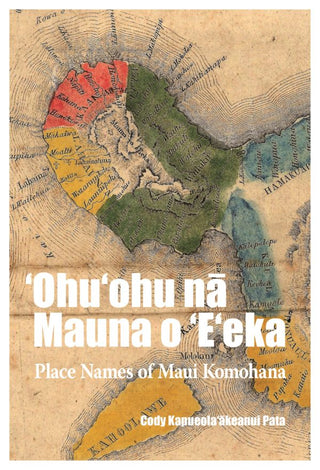Questions?

By: Cody Kapueola‘ākeanui Pata | Paperback
In ‘Ohu‘ohu nā Mauna o ‘E‘eka: Place Names of Maui Komohana, kumu hula Cody Kapueola‘ākeanui Pata gathers together more than 1,600 inoa ‘āina (place name) entries for Maui Komohana―an area of less than 200 square miles that has come to be known as “West Maui.” For Kānaka Maoli (Native Hawaiians), inoa ‘āina have since antiquity served to encode and relay meaningful information across space and time, from one generation to the next. Inoa ‘āina continue to be revered as inseparable from genealogies, individual and collective narratives, mele (poetic verse), and pule (prayers); they persist into modern times as cherished and sacred legacies deserving of deference and appreciation.
The content for ‘Ohu‘ohu nā Mauna o ‘E‘eka was compiled from dozens of maps, nineteenth- and twentieth-century Hawaiian and English language newspapers, online databases, numerous print publications, archival records, mo‘olelo and mele, recordings of Kanaka Maoli speakers, and information shared directly with the author by his elders, masters, and mentors. Whether one is a genealogical descendant of Maui Komohana, a practitioner of ‘oihana Hawai‘i (Hawaiian professions), or any other manner of scholar, this book is meant to be a resource for all researchers who wish to delve deeper into the toponymy of Maui Komohana.
Adding product to your cart
By: Cody Kapueola‘ākeanui Pata | Paperback
In ‘Ohu‘ohu nā Mauna o ‘E‘eka: Place Names of Maui Komohana, kumu hula Cody Kapueola‘ākeanui Pata gathers together more than 1,600 inoa ‘āina (place name) entries for Maui Komohana―an area of less than 200 square miles that has come to be known as “West Maui.” For Kānaka Maoli (Native Hawaiians), inoa ‘āina have since antiquity served to encode and relay meaningful information across space and time, from one generation to the next. Inoa ‘āina continue to be revered as inseparable from genealogies, individual and collective narratives, mele (poetic verse), and pule (prayers); they persist into modern times as cherished and sacred legacies deserving of deference and appreciation.
The content for ‘Ohu‘ohu nā Mauna o ‘E‘eka was compiled from dozens of maps, nineteenth- and twentieth-century Hawaiian and English language newspapers, online databases, numerous print publications, archival records, mo‘olelo and mele, recordings of Kanaka Maoli speakers, and information shared directly with the author by his elders, masters, and mentors. Whether one is a genealogical descendant of Maui Komohana, a practitioner of ‘oihana Hawai‘i (Hawaiian professions), or any other manner of scholar, this book is meant to be a resource for all researchers who wish to delve deeper into the toponymy of Maui Komohana.
Questions?
Online orders typically ship within 48 - 72 hours of placing your order.
Can't find what you're looking for? Visit us in-store to place a special order.
Are you looking to make a purchase for a school? Contact education@besspress.com for qualified discounts and a quote before placing your order.



